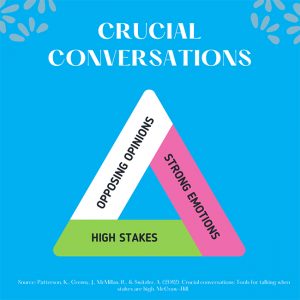Book Club: Crucial Conversations

By: Nikki Jackson, CPCU, ARM, CDMS
 It’s officially pool season in the Carolinas, which means I can be found poolside most weekends with a book in my face. The Alliance of Women in Workers’ Compensation is hosting a book club this quarter and one of the books is ‘Crucial Conversations: Tools for Talking When Stakes Are High.’ This is a wildly popular book with over five million copies sold. In the book, a crucial conversation is “a discussion between two or more people where (1) stakes are high, (2) opinions
It’s officially pool season in the Carolinas, which means I can be found poolside most weekends with a book in my face. The Alliance of Women in Workers’ Compensation is hosting a book club this quarter and one of the books is ‘Crucial Conversations: Tools for Talking When Stakes Are High.’ This is a wildly popular book with over five million copies sold. In the book, a crucial conversation is “a discussion between two or more people where (1) stakes are high, (2) opinions vary, and (3) emotions run strong (Patterson et al., 2012).” By these definitions, if you work in the claims industry, you probably have a crucial conversation every day. If you are on the front lines, helping people along their claims journey, you could have multiple crucial conversations in a day. In chapter one, the authors explain we typically handle crucial conversations in one of three ways: avoid them, face them and handle them poorly, or face them and handle them well. If we handle the crucial conversation poorly, many aspects of the claim can be affected and adversarial perceptions may develop.
vary, and (3) emotions run strong (Patterson et al., 2012).” By these definitions, if you work in the claims industry, you probably have a crucial conversation every day. If you are on the front lines, helping people along their claims journey, you could have multiple crucial conversations in a day. In chapter one, the authors explain we typically handle crucial conversations in one of three ways: avoid them, face them and handle them poorly, or face them and handle them well. If we handle the crucial conversation poorly, many aspects of the claim can be affected and adversarial perceptions may develop.
These could be crucial conversations in a workers’ compensation claim if the elements above are true:
- Denying a claim
- Suspending or terminating indemnity and/or medical benefits
- Asking an injured/ill worker to repay an overpayment
- Discussing an injured/ill worker’s return-to-work
- Asking about a second source of income
- Discussing medical or RTW non-compliance
- Engaging a medical resource to review a potential substance abuse problem
- Discussing an unfavorable IME with the injured/ill worker or their employer
- Discussing comorbidities and intervening injuries
- And more…
Chapter two goes into an overview of how to face crucial conversations well. Through their research, they discovered people that handle crucial conversations well have a way of getting “all relevant information (from themselves and others) out into the open (Patterson et al., 2012)” through the course of dialogue and make it feel safe for participants to contribute. The remainder of the book explores helpful tools to create the right conditions for dialogue. I won’t give the entire book away, but I will say the first tool really struck a nerve and reinforces the use of the advocacy approach in claims. The tool is “Start from the Heart” and it’s all about staying focused on what you really want. To do this, you must start with looking at yourself and your true motives. These are just two examples, but in these situations, the authors would encourage you to truly think about your motives and what you really want:
- It’s a Friday afternoon and you want to log off. Your phone rings and the caller ID shows your pharmacy vendor. Do you answer it or risk an injured worker heading into a weekend without their medications?
- Your closing ratio is down this month. An injured worker with a recently closed claim calls on the last day of the month and reports sharp pain and requests immediate treatment. What do you do?
If you are interested in reading this book along with me and the Alliance of Women in Workers’ Compensation, it is available to purchase on Amazon here.
Source: Patterson, K., Grenny, J., McMillan, R., & Switzler, A. (2012). Crucial conversations: Tools for talking when stakes are high. McGraw-Hill.










